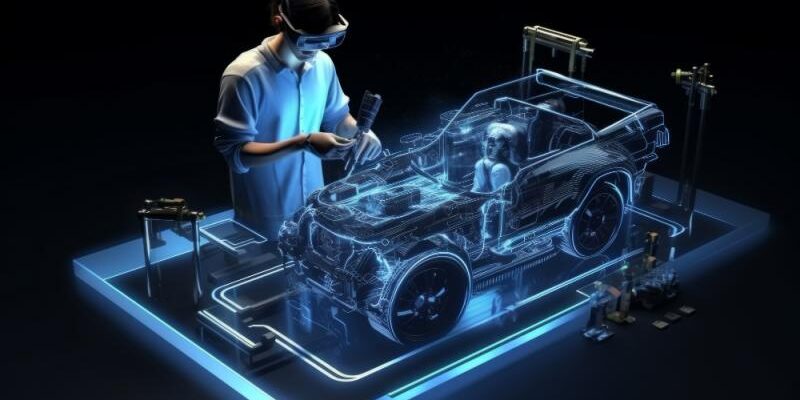Introduction
In today’s rapidly evolving automotive industry, the integration of Artificial Intelligence (AI) has become pivotal in achieving competitive advantage. AI technologies are transforming every aspect of automotive manufacturing and operations, particularly in enhancing cost efficiency and operational effectiveness. This article explores how AI is reshaping the automotive sector, focusing on its role in driving down costs while boosting productivity and innovation.
The Rise of AI in the Automotive Industry
The automotive industry has always been at the forefront of technological innovation. From Henry Ford’s assembly line revolution to the adoption of robotics in manufacturing, the sector continually seeks efficiency gains. However, the emergence of AI represents a quantum leap in this journey. AI encompasses a range of technologies, including machine learning, natural language processing, computer vision, and robotics, all of which are being leveraged to streamline operations and improve decision-making across the automotive value chain.
AI Applications in Automotive Manufacturing
- Predictive Maintenance and Quality Control:
- AI-driven predictive maintenance algorithms analyze vast amounts of data from sensors embedded in machinery and vehicles. This enables manufacturers to anticipate equipment failures before they occur, reducing downtime and minimizing maintenance costs.
- Quality control processes benefit from AI-powered computer vision systems that detect defects with greater accuracy than human inspectors, ensuring higher product reliability.
- Supply Chain Optimization:
- AI optimizes supply chain management by predicting demand fluctuations, automating inventory management, and identifying potential disruptions. This proactive approach minimizes inventory holding costs and reduces the risk of production delays.
- Robotics and Automation:
- Collaborative robots (cobots) equipped with AI are increasingly used in assembly lines for repetitive tasks, enhancing production speed and flexibility while ensuring worker safety. These robots can adapt to different tasks through machine learning algorithms, improving overall manufacturing efficiency.
AI in Automotive Design and Engineering
- Virtual Prototyping and Simulation:
- AI-powered virtual prototyping tools simulate real-world conditions and scenarios, allowing engineers to test and refine designs digitally. This iterative process reduces the need for physical prototypes, saving time and material costs.
- Generative design algorithms use AI to explore countless design permutations based on specified parameters, helping engineers discover innovative solutions that optimize performance and efficiency.
- Advanced Driver-Assistance Systems (ADAS):
- ADAS, enabled by AI and machine learning, enhance vehicle safety by providing features such as adaptive cruise control, lane-keeping assistance, and collision avoidance systems. These systems not only improve driver safety but also pave the way for autonomous vehicles.
AI and Consumer Experience in Automotive Retail
- Personalized Marketing and Customer Insights:
- AI algorithms analyze customer data to predict preferences and behaviors, enabling automakers to deliver personalized marketing campaigns and enhance customer engagement. This targeted approach increases conversion rates and customer satisfaction.
- Virtual Showrooms and Augmented Reality:
- AI-powered virtual showrooms and augmented reality applications allow customers to visualize and customize vehicles in immersive digital environments. This technology enriches the buying experience, reducing the need for physical inventory and showroom space.
Challenges and Considerations
Despite its transformative potential, the adoption of AI in automotive sector presents challenges and considerations:
- Data Security and Privacy Concerns:
- The proliferation of connected vehicles and IoT devices increases vulnerability to cyber threats. Manufacturers must implement robust cybersecurity measures to protect sensitive data and ensure consumer trust.
- Workforce Adaptation and Skills Development:
- AI-driven automation may disrupt traditional roles within the automotive workforce. To harness AI’s benefits fully, companies need to invest in retraining and upskilling employees to thrive in a digital-first environment.
- Regulatory Compliance and Ethical Considerations:
- As AI technologies become more sophisticated, regulatory frameworks must evolve to address ethical concerns, such as algorithmic bias and data privacy. Clear guidelines are essential to promote responsible AI adoption.
Future Outlook
Looking ahead, AI’s influence on the automotive sector is poised to deepen. Continued advancements in AI algorithms, coupled with the proliferation of IoT and 5G connectivity, will unlock new opportunities for innovation. From fully autonomous vehicles to sustainable manufacturing practices, AI promises to redefine the industry landscape, driving competitiveness and sustainability.
Conclusion
In conclusion, AI is not merely a technological enhancement but a catalyst for achieving competitive advantage and cost efficiency in the automotive sector. By harnessing AI’s power across manufacturing, design, engineering, and customer experience, automakers can streamline operations, innovate product offerings, and deliver superior value to consumers. Embracing AI requires strategic vision, investment in technology, and a commitment to overcoming challenges such as data security and workforce adaptation. As the automotive industry continues to evolve, AI will undoubtedly remain at the forefront of driving progress and shaping its future trajectory.
In essence, the journey towards achieving competitive advantage through AI in the automotive sector is marked by transformative potential and the promise of a more efficient, innovative, and sustainable industry landscape.











